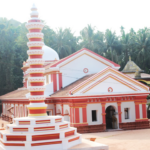The Kashi Vishwanath Temple is one of the most famous and revered temples dedicated to Lord Shiva. Located in the sacred city of Varanasi (Kashi), Uttar Pradesh, the temple is considered one of the holiest places of worship for Hindus and holds immense spiritual significance. The main deity, Vishwanath, is worshipped as the “Lord of the Universe” (Vishwa = universe, Nath = lord).
Mythological Significance:
The Kashi Vishwanath Jyotirlinga is one of the twelve Jyotirlingas of Lord Shiva, making it one of the most significant Shiva temples. According to Hindu mythology:
- Creation of Kashi:
- It is believed that Lord Shiva established Kashi (Varanasi) as his own city, one of the oldest continuously inhabited cities in the world. The city is considered to be situated at the trishul (trident) of Lord Shiva.
- Shiva declared Kashi as his eternal home, and it is believed that those who die here attain moksha (liberation from the cycle of birth and death), making Varanasi a key destination for salvation seekers.
- The Jyotirlinga Legend:
- The Vishwanath Jyotirlinga is said to have manifested in Varanasi, representing the infinite and formless aspect of Shiva. The Jyotirlingas are believed to be the supreme manifestation of Lord Shiva, and each Jyotirlinga shrine is a focal point of divine energy.
- Legend has it that Lord Brahma and Lord Vishnu once had a dispute about who was the supreme being. To settle the argument, Lord Shiva pierced the three worlds as a massive column of light (the Jyotirlinga). Vishnu and Brahma attempted to find the end of the light but failed, acknowledging Shiva’s supremacy.
- Mother Parvati’s Desire:
- According to another legend, Goddess Parvati, Lord Shiva’s consort, expressed her desire to live in Kashi. To fulfill her wish, Lord Shiva left Mount Kailash and established his abode in the sacred city, where he resides as Vishwanath, the Lord of the Universe.
Historical Significance:
The temple has a long and complex history marked by periods of destruction and reconstruction:
- Ancient Origins: The original Vishwanath Temple is believed to have existed since ancient times, although the exact date is uncertain. It has been rebuilt several times due to repeated invasions and destruction by foreign rulers.
- Destruction and Reconstruction:
- The temple was destroyed multiple times by invaders, including Qutb-ud-din Aibak and later by the Mughal emperor Aurangzeb, who built the Gyanvapi Mosque on its original site.
- The current structure of the temple was built by Ahilya Bai Holkar, the queen of Indore, in 1780. Later, Maharaja Ranjit Singh of Punjab donated gold to cover the temple’s shikhara (spire), giving the temple its iconic golden appearance.
Architectural Features:
- Golden Spire (Shikhara): The Kashi Vishwanath Temple is known for its gold-plated spire, which stands out as a landmark feature. The gold was donated by Maharaja Ranjit Singh, adding to the temple’s grandeur.
- Mandir Layout: The temple follows the traditional Nagara style of Hindu temple architecture. The main shrine houses the Vishwanath Jyotirlinga, a small, black stone that is revered as the embodiment of Lord Shiva.
- Sacred Gyanvapi Well: Located near the temple, the Gyanvapi Well is considered sacred by devotees. Legend has it that the original Jyotirlinga was hidden in this well to protect it from invaders during one of the attacks on the temple.
Spiritual Significance:
- Kashi as a Moksha-Daayi City: Varanasi is considered the city of moksha, and it is believed that anyone who dies here attains liberation from the cycle of rebirth. Lord Shiva is said to whisper the Taraka Mantra (“Om Namah Shivaya”) into the ears of those who die in Varanasi, ensuring their salvation.
- The Vishwanath Jyotirlinga: As one of the twelve Jyotirlingas, the Kashi Vishwanath Jyotirlinga represents the infinite nature of Lord Shiva. It is said to have immense spiritual power, and devotees believe that praying here can cleanse one of sins and lead to spiritual upliftment.
- An Integral Part of Hindu Pilgrimage: The Kashi Vishwanath Temple is a vital part of the Panch Kedar Yatra, along with other holy sites such as Kedarnath. It also plays a significant role in the Sapta Puri pilgrimage, a group of seven sacred cities in India that are believed to offer spiritual liberation.
Rituals and Festivals:
- Abhishekam: The primary ritual at the Vishwanath Temple is the Abhishekam, in which the Shiva Lingam is bathed with water, milk, honey, ghee, and flowers. This is performed daily by devotees as a sign of reverence.
- Maha Shivaratri: This is the most important festival celebrated at the Kashi Vishwanath Temple. Thousands of devotees gather at the temple to offer prayers to Lord Shiva. The festival marks the marriage of Lord Shiva and Goddess Parvati and is observed with fasting and night-long vigils.
- Ganga Aarti: The evening Ganga Aarti at the Dashashwamedh Ghat near the temple is one of the most spectacular and spiritually uplifting experiences for pilgrims. Devotees gather to witness priests perform the Aarti with lamps, accompanied by the chanting of mantras and the sound of bells.
- Pradosh Vrat: Special rituals are conducted on Pradosh Vrat, which falls on the 13th day of both the waxing and waning phases of the moon. It is considered an auspicious day to worship Lord Shiva, and devotees offer special prayers and perform fasting.
How to Reach:
- Varanasi is well connected by road, rail, and air. The nearest airport is Lal Bahadur Shastri International Airport, and the city has excellent rail connectivity to major cities in India. The temple is located near the Dashashwamedh Ghat, one of the most important ghats on the River Ganga.
- Pilgrims and tourists often visit the temple as part of their spiritual journey to Varanasi, which is also famous for its ancient ghats, spiritual rituals, and historical significance.
Conclusion:
The Kashi Vishwanath Temple is not only a revered Shiva temple but also a cornerstone of Hindu spirituality and culture. Its deep connection to the mythological and historical legacy of Varanasi makes it one of the most visited and sacred places for devotees. Visiting this temple is believed to grant spiritual blessings, cleanse sins, and lead to ultimate liberation (moksha). The Vishwanath Jyotirlinga stands as a beacon of divine energy, offering devotees a path to both worldly and spiritual fulfillment.













